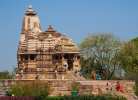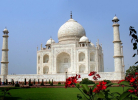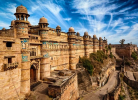Architecture of Taj Mahal
‘A teardrop on the cheek of eternity’ that is how the famous Indian poet Rabindranath Tagore described Taj Mahal. Rudyard Kipling, the famous English poet praised the beauty of Taj Mahal by saying it is ‘ the embodiment of all things pure’. And the creator of Taj Mahal, the Mughal Emperor Shah Jahan said it made ‘the sun and the moon shed tears from their eyes. No wonder Taj Mahal is one of the most fascinating architectural marvels in the world. Every year lakhs of tourists visit Agra to see the beauty of Taj Mahal.
Taj Mahal is an extremely beautiful mausoleum made of white marble between 1631 and 1648 under the aegis of the Mughal Emperor Shah Jahan. It is ideally located on the banks of River Yamuna in Agra. It costed around 32 crores during that time. He built it in the memory of his beloved wife Mumtaz Mahal. Its architectural beauty has earned it two prestigious titles, ‘UNESCO World Heritage Site’ and ‘One of the Seven Wonders of the World’.
Architectural features of Taj Mahal
Taj Mahal is universally admired for its incredible architecture. It is the most sparkling jewel of Muslim Art in India. Built with pure white marble (obtained from Makrana, Rajasthan) having extraordinary luster and texture. The monument covers an area of 42 acres. The monument is encircled by lush green gardens, lovely pools, and fountains.
The main gateway located at the end of the long watercourse was originally made of solid silver.
The complex of Taj Mahal majorly consists of five structures - Darwaza (main gateway), Bageecha (gardens), Masjid (mosque), Rauza (main mausoleum) and Naqqar Khana (rest house).
The Taj Mahal complex consists of the tomb at its center (58 feet in diameter and 81 feet high). It is the main attraction. It is built in white marble at a square plinth raised 50 above riverbank to avoid seepage. There are four minarets on each side of the square which are deliberately made 137 m in height to emphasize the beauty of the dome. These minarets are a little titled outwards instead of standing straight. The reason why it was built like this was to protect the tomb from being damaged in case any of the minarets falls due to any natural calamity.
Inside the Taj Mahal lies the tombs of both Mumtaz Mahal and Shah Jahan. Both the tombs are inlaid with semi-precious stones. The tomb of Mumtaz Mahal features calligraphic inscriptions of the 99 names of Allah.
Architectural Styles
Taj Mahal is a perfect amalgamation of Indian, Islamic and Persian architectural styles. It took around 22,000 workers to build this monument. Stonecutters, painters, masons, dome builders, calligraphers, inlayers, carvers and other artisans were called from all over Asia and Iran.
It leaves the onlookers gape in awe. It is not only beautiful but built in such a way that even after hundreds of years, it still holds that fineness and charm. The chief designer of this mesmerizing monument was Ustad Ahmad, who was an architect in the court of Shah Jahan from Lahore.
Calligraphy on Taj Mahal
The calligraphy on the Taj Mahal is beautiful. The beauty of the black inscriptions over the white marble is an attractive feature of the edifice. The walls and pillars of the monuments are also adorned with calligraphy written in Thuluth script. Most of the inscribed verses are from the holy book of Islam- Quran.
Interesting Facts about Taj Mahal
- 28 types of semi-precious and precious stones were sourced from Sri Lanka, China, Tibet and other parts of India to adorn Taj Mahal.
- Construction material was sourced from across India and around 1,000 elephants were used for transportation.
- Taj Mahal is taller than Qutub Minar (5 feet taller).
- Around 8 million people visit Taj Mahal every year.
- Taj Mahal reflects different colours depending on the light. In the morning, it looks a little pinkish, in the afternoon with strong sunlight it appears shimmering white, milky white in the evening and golden at night.
- The Taj Mahal has an active working mosque in its complex and that is the reason why it is closed on Friday.
















